The latest piece has just been finished – a Limbert style cabinet in hard maple with ash-veneered panels and doors having stained glass made by a local maker as well as forged black iron hinges and handles. Stringing is dyed (black) holly with small stoppers and dowel-covers of African blackwood.
The basic construction is frame and panel – sides, back, top, bottom, shelves and even the doors. One shelf is removable, with two sets of brass supports in two positions to cater to contents of different heights. At present, its a bookcase.
The finish is 3 coats of Liberon Finishing Oil which will eventually (when fully dried) be given a coat of wax to bring up the shine.
The inset panels on the top and in the shelves (unseen) are from scraps of plywood, outlined in the black holly stringing.
The Nautilus, by the way, was made by a local blacksmith from old wrought iron rails and other parts salvaged from an old quarry in the Welsh Preseli hills.
The first pic was taken before the cabinet was completely finished; and empty, to show the stained glass. Eventually, I hope to illuminate it properly with some LED strips around the periphery of the door insides.
Lataxe
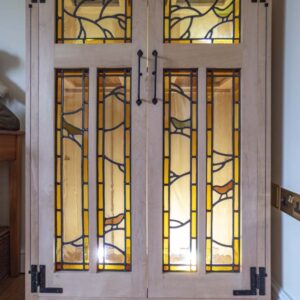
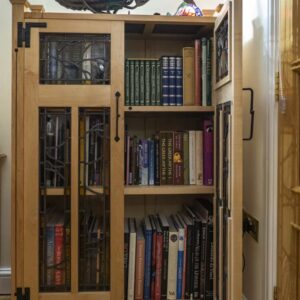
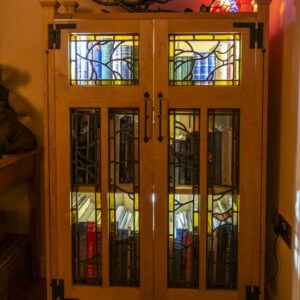
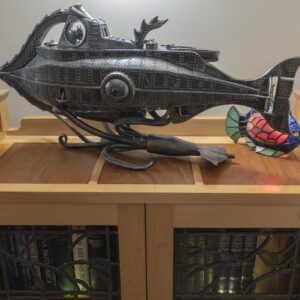
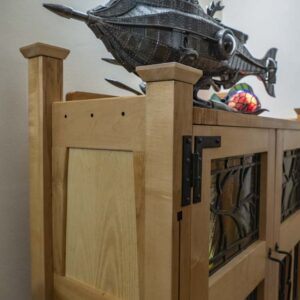















Replies
Very nice. After I finish my current project (Becksvoort's 15 drawer cabinet), I have the lumber on the shelves to do a Limbert 3 sided book case; for get the model number but it's one of the popular ones.
As usual, great work lat_axe. It's nice to know a blacksmith nearby.
Beautiful work! My best to you for a great 2024!
Stunning work Lataxe.
Oh that is very nice.
So we are posting projects on the discussion forum now?
Asking for a friend...
Seems like that's what the galleries are for. All 6 "disussion" slots will fill pretty quick with "praise me" posts.
Once upon a time, a long time ago, this forum (the FWW forum) was named Knots and contained immense amounts of useful, interesting and often detailed information about woodworking. Many posted pics of their projects and even post-series describing the stages of their making, with photos and on-going discussions with others about the details.
There were many characters, including a large number of extremely able woodworkers full of experience-based knowledge they were more than happy to share and elaborate on. Happy days, now passed.
These days, the forum seems to have a lot of Twitter and FB-style posts - short and empty of any interest or content. There seems also to be a number of rather arrogant old men about, issuing orders about how the forums should only be used as they direct, usually telling us to make no posts at all or to only say things with which they agree. :-)
This cabinet is beautiful and the detailed description instructive. I learned about Liberon finishing oil, for example, as something I want to try in the future. So as a beginner, I’d appreciate seeing, and reading about the processing of completing, more finished projects from experienced makers.
As with all the things one makes of wood, even after a few hundred, lessons can be learnt.
I've made other frame & panel cabinets of various sorts, of various timbers, and learnt one hard lesson - frame and panel constructions need the timber to be well-matured if post-assembly warpages are not to appear, making doors fit badly, showing unwanted and/or uneven gaps here and there or even warping the whole piece.
This cabinet was made of various chunks of reclaimed maple (remnants from much larger first & second fitting jobs of a friend's business) that has been stored in house-atmosphere conditions for about ten years. As a result, the parts have remained unwarped and "true" within the whole. Phew!
Liberon Finishing Oil, by the way, used to be advertised as a mixture of tung oil, "other" oils, alcohol and "driers". These days there's no mention of tung oil, just "a mixture of oils". Nevertheless , its a very good and relatively quick drying oil finish that does build a good sheen that doesn't "plasticise" the look of the wood.
It's still advertised as suitable for kitchens and bathrooms but I wouldn't use it there as standing water on it will eventually penetrate and raise the grain. Osmo Top Oil is much more resilient when a piece is going to get wet regularly.
Hey, cheer up it’s New Year !